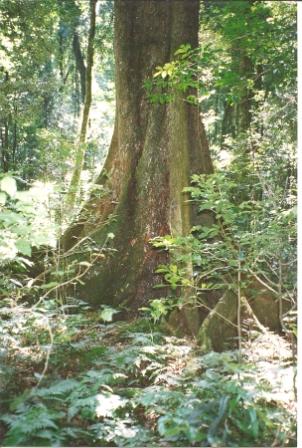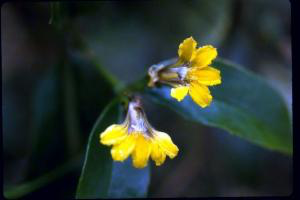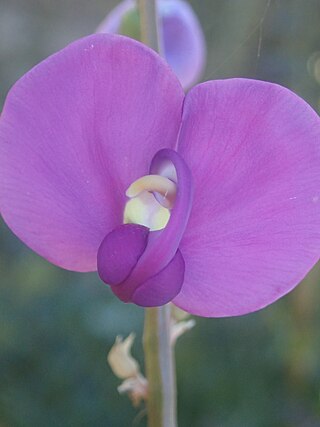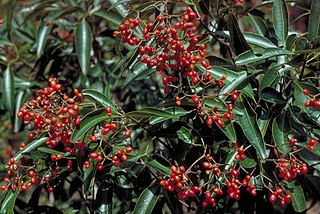
Eucalyptus erythrocorys, commonly known as illyarrie, red-capped gum or helmet nut gum, is a species of tree or mallee from Western Australia. It has smooth bark, sickle-shaped to curved adult leaves, characteristically large flower buds in groups of three with a bright red operculum, bright yellow to yellowish green flowers and sculptured, bell-shaped fruit.

Argyrodendron actinophyllum, commonly known as black booyong, black jack, stave wood, Mackay tulip oak, crowsfoot elm, booyong, tulip oak or blush tulip oak, is a species of flowering plant in the family Malvaceae and is endemic to eastern Australia. It is a large tree with prominent buttress roots, palmately compound leaves with 5 to 9 lance-shaped leaflets, flower arranged in panicles, and winged samaras.

Hymenosporum is a monotypic genus of trees in the family Pittosporaceae. The sole included species is Hymenosporum flavum, commonly known as native frangipani, found in the rainforests and wet sclerophyll forests of New Guinea, Queensland and New South Wales. Despite its common name, it is not closely related to the frangipani, but is related to the widespread genus Pittosporum.

Eucalyptus megacarpa, commonly known by its Noongar name of bullich, is a species of robust mallee or small to medium-sized tree with a scattered distribution in the forests of the south-west of Western Australia. It has smooth bark throughout, lance-shaped to curved adult leaves, flower buds in groups of three, white flowers and cup-shaped, bell-shaped or hemispherical fruit.

Woollsia pungens, commonly known as snow heath, is the sole species in the flowering plant genus Woollsia in the family Ericaceae and is endemic to eastern Australia. It is a small shrub with egg-shaped leaves with a heart-shaped base, white to dark pink, tube-shaped flowers and small capsules containing many small seeds.

Tasmannia membranea, commonly known as pepper tree, is a species of flowering plant in the family Winteraceae, and is endemic to north-eastern Queensland. It is a shrub or tree with lance-shaped or egg-shaped leaves, male and female flowers on separate plants, with two petals on each flower. The male flowers have 30 to 62 stamens, and the female flowers have a single carpel with 14 to 36 ovules, and the fruit is black.

Phymatocarpus is a genus of flowering plants in the family Myrtaceae and is endemic to the south-west of Western Australia. All three species are shrubs with pink to purple flowers.

Arthrochilus, commonly called elbow orchids, is a genus of about fifteen species of flowering plants from the orchid family (Orchidaceae) and is found in Australia and New Guinea. The flowers are pollinated by male thynnid wasps which attempt to mate with the flower and are held in place by hooks while the pollinium is transferred between insect and flower.

Cordyline manners-suttoniae, commonly known as the giant palm lily, is an evergreen plant found only in rainforest of northeastern Queensland, Australia.

Archidendron lucyi is a small tree in the legume family Fabaceae. The native range extends from eastern Malesia to the Solomon Islands and northeastern Australia. A. lucyi grows in the understorey of lowland rainforest.

Palmeria is a genus of about 17 species of flowering plants in the family Monimiaceae mostly native to Australia and New Guinea. One species is also native to Sulawesi and the Bismarck Archipelago. Plants in the genus Palmeria are woody climbers or climbing shrubs with usually 7 to 15 flowers, the flowers either male or female.

Prostanthera prostantheroides is a plant in the family Lamiaceae and is endemic to Western Australia. It is a shrub with heart-shaped to round leaves and usually white flowers with purple spots inside the petal tube.

Corymbia watsoniana, commonly known as large-fruited yellowjacket, is a species of tree that is endemic to Queensland. It has rough, tessellated bark on the trunk and branches, egg-shaped to broadly lance-shaped adult leaves, flower buds in groups of seven, creamy white flowers and barrel-shaped or urn-shaped fruit.

Scaevola enantophylla, commonly known as climbing fan-flower,is a species of flowering plant in the family Goodeniaceae and is endemic to Queensland. It is a scrambling vine with yellow fan-shaped flowers, and the only species in the genus with leaves arranged opposite.

Swainsona procumbens, commonly known as Broughton pea or swamp pea is a species of flowering plant in the pea family (Fabaceae), and is native to Australia. It is a spreading or ascending perennial shrub-like herb with imparipinnate leaves with 15 to 25 linear to narrowly lance-shaped leaflets with the narrower end towards the base, and racemes of 2 to 12 purple or mauve to pink flowers.

Dinosperma is a genus of plant containing the single species Dinosperma erythrococcum, commonly known as tingletongue, clubwood or nutmeg, and is endemic to north-eastern Australia. It is a tree usually with trifoliate leaves arranged in opposite pairs, the leaflets lance-shaped to oblong, and panicles of small white flowers, later bright orange to red, slightly fleshy follicles containing shiny, bluish black seeds.

Mackinlaya macrosciadea, commonly known as mackinlaya or blue umbrella, is a plant in the carrot, fennel and parsley family Apiaceae, found in the Northern Territory and Queensland, Australia.

Benstonea monticola, commonly known as scrub breadfruit or urchin-fruited pandan, is a plant in the family Pandanaceae which is endemic to rainforested parts of north east Queensland, Australia.

Styphelia strongylophylla is a species of flowering plant in the heath family Ericaceae and is endemic to the southwest of Western Australia. It is an erect shrub with crowded egg-shaped or round leaves and white, tube-shaped flower arranged singly or in pairs in leaf axils.

Leptorhynchos tenuifolius, commonly known as wiry buttons, is a species of flowering plant in the family Asteraceae. It is an upright to ascending herb, multi-branched and has yellow flowers and grows in Victoria and South Australia.





















